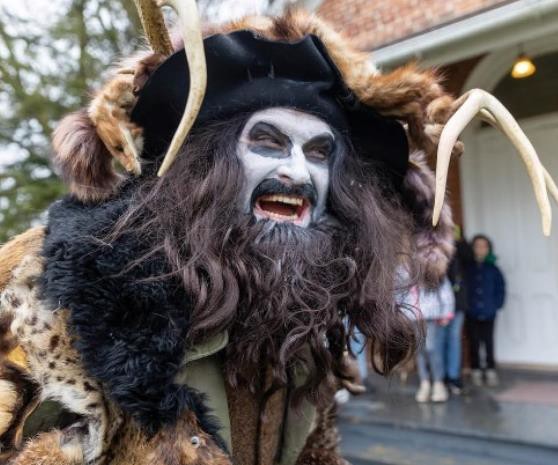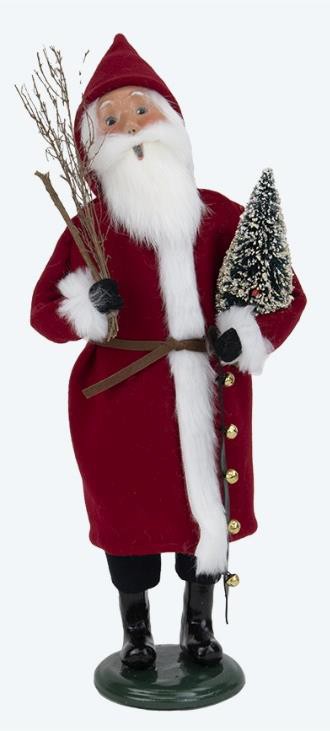He sees you when you’re sleeping, he knows when you’re awake,
He knows if you’ve been bad or good, so be good for goodness sake!
– Santa Claus is Coming to Town, J. Fred Coots, Henry Gillespie, 1934
Have you ever wondered HOW Santa Claus knows all this? Does he have a crystal ball? How about an all-seeing telescope … or a spy? Now we’re getting close!
For the Pennsylvania Germans of the 1700s, Santa Claus — just one of his many aliases — did have a spy. He arrived with those colonial-era immigrants from the southwestern region of the German Palatinate — along the Rhine — where Saint Nicholas had a mischievous ambassador known as the Belsnickel. “Bels” arrived a week or so before St. Nick, and it was he who peeked into children’s houses, watched them at play, and observed their behaviors.
Belsnickel would report to Santa all the good and bad actions of the little ones. And if he found them wanting, he would correct them with the switch he carried for just such purposes. Belsnickel — the name derives from the German for “fur” (pelz) and Nicholas — most often was depicted as an ill-tempered old man dressed in ragged clothes and furs who went around terrorizing children.

Belsnickel at the annual Christmas on the Farm event at the Pennsylvania German Cultural Heritage Center in Kutztown.
Locally, his first encounter with children was the rapping of his switch on windows, followed by a slow and gentle opening of the door — left unlocked by a parent or older child. Belsnickel would then toss a few nuts on the floor, raising the curiosity of the little ones in the house. A few minutes later, more nuts rattling across the floor would entice the brave ones to gather them despite their fear. At this point, the Belsnickel — dressed in a masked costume — would quickly wield his switch across their knuckles, followed by a capture with the pretense of punishment. This sudden change would terrify them into performing any suggested acts of a song, dance, or jig.
As with many traditions brought to America, the name and character ascribed to Santa Claus/St. Nicholas and his sidekicks vary in rural and urban areas. In old northern German myths, he is known as Knecht Ruprecht. Other accounts call him Krampus or Pelzsnickle. One common thread in the versions of Belsnickel describe an old man dressed in a long cloak, pointed hood, fur around the neck, a long white beard, and carrying a large sack. Belsnickel may even have hidden in homes and moved from room to room while keeping watch over the children’s behavior. Does the modern “elf on the shelf” come to mind?
Sometimes the Belsnickel would approach village children in a crackly, undetectable language, asking them whether they were good. All children, of course, would claim good behavior. If Belsnickel was satisfied, they would be rewarded with a treat of nuts. If perchance, they were too honest in claiming their good deeds — or had an older sibling who disputed their response — Belsnickel would lash out with his switch.
In Indiana, Belsnickel carried a large book in which the names of children and their good or bad deeds were kept. After a Belsnickel report, Santa’s “list would be checked twice to see who was naughty or nice.” Good children received a treat, and bad children would get Belsnickel’s switch or possibly a lump of coal.
In midwestern Pennsylvania, Belsnickel was regaled with parades. Almost Mardi Grad style — and dressed in costumes as clowns, Indians, and demons — many were quite proficient in playing instruments such as violins, tambourines, and bones. They danced about, warbling in frightening sounds, perhaps from an overindulgence at the liquor store.
In the Souderton-Telford area, this was a tradition practiced mainly by Lutheran and Reformed folks. A letter to the editor in the Souderton Independent described the Christmas Eve “Bells Nickel” visits remembered from the author’s childhood. Sometimes there were five or six of them in a bunch, dressed in all sorts of ragged clothing with switches in hand.

This kinder, gentler version of Belsnickel is sold by Byers’ Choice in Chalfont.
Children were made to kneel down and say their prayers. If they refused, the switch would come down across their backs. Candy and nuts would be tossed on the floor, and when the children had promised to obey their parents and be good girls and boys, the Bells Nickel would move on to the next house.
But some also had memories of a more comical Belsnickel. Schwenkfelder Elmer Johnson told a tale of one Belsnickel who began rapping at the front door, then proceeded to the side door, and while rapping on the back door, fell into the water trough.
Though the tradition was shunned by both Mennonites and Amish of the area, perhaps locals heard about the practice in which a group of young boys would do the window rapping, and thus generated the Pennsylvania Dutch expression “snickle-fritz,” referring to a naughty child.
Philadelphian William Duane, in an 1853 article in a British magazine, referred to “Pelsnichol.” Some observers believed Pelsnichol was the same as “Krishkinkle,” but most believed they were two characters: one rewards the good, the other punishes the bad. Duane wrote the Pelsnichol merely left a birch rod in the stockings of naughty children.
By the end of the 19th century, the custom of Belsnickel was greatly reduced, almost to oblivion, as too many children apparently had been traumatized by the antics of these rogues. And punishment was not considered appropriate for the giving spirit of Christmas.
Modern-day Santa, as described in Clement Moore’s Twas the Night before Christmas, has been updated to a jolly man in a red suit who arrives in a sleigh pulled by eight reindeer. He has a more challenging entry down the chimney. And his assistants are friendly, hard-working elves who remain in the workshop, leaving him to make advance check-ups on his own.
If the tale of Belsnickel is too grim, and you think your little ones may be frightened by the idea, head over to the Indian Valley Public Library, and check out Pennsylvania Dutch Night before Christmas. According to the library catalog, the “Pennsylvania Dutch dialect and the antics of the crotchety Belsnickel will make this a Christmas tale to enjoy.” Have fun with the dialect!
You can also practice wishing neighbors “Hallicher Grischtdaag” in Pennsylvania Dutch.
